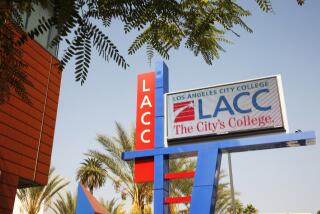Finding Unusual Scholarships
- Share via
Do you plan to become a car mechanic, farmer, nurse, firefighter, secretary, politician, biologist, psychologist or engineer? Are you Greek, American Indian, Polish, Syrian, Japanese, Danish, Latino or black? Are you or your parents members of a professional or social organization, such as the Kiwanis Club, the American Legion, a state bar association or a church?
If the answers to any of those questions are yes, you may qualify for one of thousands of college scholarships and loans that fall into the category of “private donor” and “restricted recipient” awards.
Unlike federal and state financial aid programs, information about these private donor awards is not always included in economic aid packages prepared by your college or university, experts say. In many cases, students must find out about them on their own and ask to apply.
Although that makes the financial aid search a bit tougher, it can be worth it. Many private donor awards go unclaimed each year because students and their counselors are unaware of them, financial aid experts say.
How much can these private awards pay? Anything from $50 to the entire cost of your college education.
For example, minority students wishing to study medicine can receive up to $6,000 per year for eight years at Hope College and the University of Michigan under a recently launched joint scholarship program. That’s in addition to other forms of student aid.
Fort Lewis College in Durango, Colo., offers free tuition to “Native American” students who meet academic standards and whose bloodlines can be verified.
However, these awards are unusual. Typically, private donor and restricted recipient awards pay substantially less than what’s provided under state and federal programs. But, then again, there are far more of them, and your child may qualify for several. That can add up. Consider this your own personal treasure hunt.
Where do you start? Sit down with a note pad and pencil and start writing out a list of companies, trade groups, professional and social organizations that your family is involved with.
The list should include everything from the companies that you, your parents (and even grandparents) work for, to fraternities, sororities and social clubs. If you know your personal and ethnic history, this can also be a plus.
Why? Some organizations give scholarships to descendants of Confederate soldiers or to those whose ancestors sailed on the Mayflower. And, often, American Indian lineage can prove valuable when applying for financial aid. even if the bloodline has become highly diluted.
You can even get an award for having the right surname, says Margaret Mottier, director of Encyclopedia Britannica’s Instant Research Service in Chicago. Yale gives grants to students named Leavenworth. Students named Zolp can qualify for a full scholarship at Loyola University in Chicago.
If you have a special talent, or know what you want to study, that helps too. Those with music, art or drama skills, for example, can tap into dozens of scholarships that pay from $100 to $1,000. And students who major in math or science often can find even more lucrative awards given by companies wishing to encourage study in these areas. Often, professional organizations in your state are able to provide details.
But keep your eyes peeled. There is no one-stop shopping for these types of awards and scholarships. And at this time of year, some donors are actually advertising to give away money.
After making up your list, you’ll need to do some legwork. Specifically, you must call or write each organization on your list to find out if they offer loans or scholarships.
It is important to note that very little is standard about these grants. The amount you get can vary based on need, merit, the college you go to and other limitations--it’s totally up to the organization that provides the money.
The requirements and application deadlines also differ with each group, so it is best to start early--sometimes as much as a year before your child enrolls in college.
More to Read
Sign up for Essential California
The most important California stories and recommendations in your inbox every morning.
You may occasionally receive promotional content from the Los Angeles Times.













